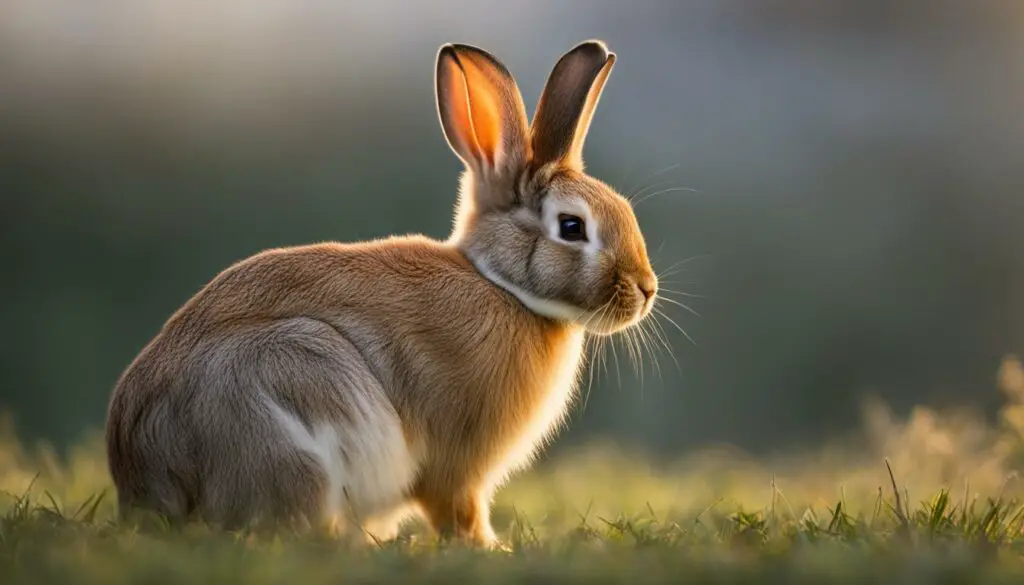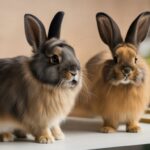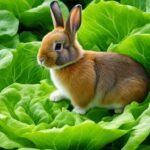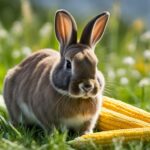As a rabbit enthusiast, I have always been fascinated by the unique features that these furry creatures possess. One such feature that has captured my attention is the rabbit dewlap. A dewlap is a pouch of fat beneath the jaw of a female rabbit, and it can vary in size depending on the breed and individual genetics. In this comprehensive guide, I will delve into everything you need to know about rabbit dewlaps, from their characteristics and development to their impact on a rabbit’s health and care.
Key Takeaways:
- A dewlap is a pouch of fat beneath the jaw of a female rabbit, especially if they were not spayed early.
- Dewlaps are more prominent in large breeds and lop eared rabbits.
- Female rabbits develop dewlaps to help when it comes time to make a nest for their babies.
- Male rabbits of certain breeds may also develop small dewlaps.
- Monitoring a rabbit’s dewlap and maintaining a healthy weight are key factors in preventing dewlap-related health issues.
Characteristics of a Rabbit Dewlap
A dewlap is a distinctive feature of female rabbits, located beneath their chin. It appears as a bump or pouch of fur, varying in size depending on the breed and individual genetics. Small dewlaps can resemble a double chin, while larger ones can encircle the rabbit’s head. The size of the dewlap is typically more prominent in larger breeds like Flemish Giants and lop rabbits. To envision a rabbit dewlap, imagine a small pouch of fur beneath the chin.
Table 2 summarizes the characteristics of a rabbit dewlap, highlighting the variation in size and appearance.

| Dewlap Size | Appearance | Breed |
|---|---|---|
| Small | Resembles a double chin | Smaller rabbit breeds |
| Large | Encircles the rabbit’s head | Larger breeds like Flemish Giants and lop rabbits |
As shown in Table 2, dewlap size varies based on breed, with smaller breeds having a smaller or almost non-existent dewlap. In contrast, larger breeds tend to have larger dewlaps that can encircle the rabbit’s head. The appearance of the dewlap can range from resembling a double chin to forming a complete circle around the neck.
Development of a Rabbit Dewlap
When it comes to the development of a rabbit dewlap, there are a few key factors to consider. Female rabbits do not have a dewlap at birth, but it begins to develop as they reach sexual maturity, typically around four to six months old. Over the next year or two, the dewlap will continue to grow until it reaches its full size. It’s important to note that the size of a rabbit’s dewlap is primarily determined by genetics.
In some cases, excessive pulling of fur from the dewlap or rapid growth may indicate underlying health issues. If you notice any abnormal changes, such as sudden enlargement or inflammation, it’s essential to have your rabbit checked by a veterinarian. By addressing any potential problems early on, you can prevent further complications and ensure the overall well-being of your furry friend.
Managing rabbit dewlap issues is an essential part of maintaining their health and comfort. Regular grooming is crucial to prevent matting and keep the area clean. If your rabbit has a larger or more prominent dewlap, you may need to take extra care to ensure it stays dry and free from any potential infections. Additionally, monitoring their weight and providing a balanced diet can help prevent obesity, which can contribute to the size of a rabbit’s dewlap.
Preventing Rabbit Dewlap Problems
To prevent rabbit dewlap problems, there are several steps you can take. First and foremost, ensure your rabbit’s diet is well-balanced and appropriate for their age and breed. Avoid overfeeding and provide plenty of opportunities for exercise to help them maintain a healthy weight. Regular grooming is also essential to keep the dewlap clean and free from matting. You can use a soft brush to gently comb through the fur around the dewlap, being careful not to cause any discomfort or irritation.
It’s important to be proactive in monitoring your rabbit’s dewlap for any signs of infection or inflammation. If you notice any redness, swelling, or discharge, it’s best to consult with a veterinarian for proper diagnosis and treatment. They may recommend topical ointments or antibiotics to help resolve any issues. By following these preventive measures and staying vigilant in caring for your rabbit’s dewlap, you can ensure their continued well-being and happiness.
| Preventive Measures for Managing Rabbit Dewlap Issues | Benefits |
|---|---|
| Regular grooming | Prevents matting and keeps the area clean |
| Maintaining a healthy weight | Prevents obesity, which can contribute to dewlap size |
| Monitoring for signs of infection or inflammation | Allows for early detection and appropriate treatment |
Dewlap Size and Health Concerns
When it comes to rabbit dewlaps, size matters. While a dewlap is a normal and healthy feature in female rabbits, a very large dewlap can pose problems for the rabbit’s health. It can make grooming, eating, and drinking difficult, and can lead to skin irritation or infections. Obesity can also contribute to the size of a rabbit’s dewlap. Monitoring and maintaining a healthy weight can help prevent dewlap-related health issues.
Proper care and management of a rabbit’s dewlap are crucial for maintaining their overall well-being. Regular grooming is essential to prevent matting and skin issues. For rabbits with larger or more prominent dewlaps, extra care may be needed to keep the area clean and dry. Checking the dewlap regularly for any signs of infection or inflammation is important.
It’s important to note that male rabbits can also develop dewlaps, although it is less common compared to female rabbits. Male dewlaps are usually smaller and often associated with weight gain. Neutering a male rabbit before puberty can increase the chances of developing a dewlap, as it changes the hormone balance in their body. However, a dewlap in male rabbits is generally not a cause for concern unless it is accompanied by other health issues.
Health Concerns Associated with Dewlap Size:
- Difficulty grooming, eating, and drinking
- Skin irritation or infections
- Obesity
| Dewlap Size | Potential Health Concerns |
|---|---|
| Small to moderate | No significant health issues |
| Large | Grooming difficulties, skin infections |
| Very large or excessive | Obesity, increased risk of health problems |
Regular veterinary check-ups are important to monitor the health of a rabbit’s dewlap. This will help identify any potential issues early on and ensure appropriate action is taken. Maintaining a healthy diet, providing regular exercise, and keeping the dewlap clean and dry are all important aspects of dewlap care.

Male Rabbits and Dewlaps
Male rabbits can also develop dewlaps, although it is less common compared to female rabbits. While dewlaps in males are generally smaller, they can still be associated with weight gain. It is important to note that neutering a male rabbit before puberty can increase the likelihood of developing a dewlap, as it alters the hormone balance in their body.
However, it is essential to understand that a dewlap in male rabbits is typically not a cause for concern unless it is accompanied by other health issues. If you notice any unusual changes or abnormalities in your male rabbit’s dewlap, it is recommended to consult with a veterinarian to rule out any underlying health problems.
Common Health Issues Associated with Male Rabbit Dewlaps
Although dewlaps in male rabbits are generally less significant than in females, they can still contribute to certain health concerns. Excessive dewlap size and weight gain can make grooming, eating, and drinking more difficult for male rabbits. Additionally, a large dewlap can increase the risk of skin irritation and infections in the area. It is crucial to monitor your male rabbit’s dewlap and overall weight to ensure their well-being and address any potential health issues in a timely manner.
| Health Concerns | Symptoms |
|---|---|
| Grooming Difficulties | Excessive matting or soiling of fur around the dewlap area. |
| Eating and Drinking Difficulties | Unusual behavior while eating or drinking, such as struggling or avoiding food/water. |
| Skin Irritation and Infections | Redness, swelling, discharge, or signs of discomfort around the dewlap. |
Regular care and maintenance, including grooming and monitoring your male rabbit’s weight, can help prevent and manage any potential issues related to their dewlap. However, it is important to remember that individual rabbits may have different needs and predispositions, so consulting with a veterinarian is always advisable for personalized guidance and care recommendations.
Dewlaps in Show Rabbits
The world of rabbit shows is diverse and fascinating, with each breed having its own specific standards and criteria for evaluation. When it comes to dewlaps, different breeds have varying expectations. Some breeds require a prominent and well-developed dewlap as part of their breed standard, while others prefer a minimal or even nonexistent dewlap. Understanding the specific requirements of each breed is essential for rabbit exhibitors and breeders to ensure their rabbits meet the standards and are eligible for competitions.
One breed that puts a significant emphasis on the dewlap is the Flemish Giant. These gentle giants are known for their large size and distinctive dewlaps. In the show ring, a well-developed, firm, and symmetrical dewlap is highly desirable. Judges will closely examine the dewlap, evaluating its size, shape, and overall condition. A properly conditioned and presented Flemish Giant with an impressive dewlap can make a strong impression and increase the chances of success in the show ring.
On the other hand, some breeds, such as the Netherland Dwarf, have different standards for the dewlap. The Netherland Dwarf is a small and compact breed that does not typically have a prominent dewlap. In fact, a minimal or even absent dewlap is preferred in this breed. Judges will look for a smooth and well-rounded transition from the neck to the chin, without a noticeable dewlap. This breed showcases the diversity and uniqueness within the rabbit show world, where different breeds have their own distinct characteristics and preferences.
It is important for rabbit exhibitors and breeders to familiarize themselves with the specific breed standards for dewlaps. This knowledge allows them to select and breed rabbits that meet the desired criteria and have the potential to excel in the show ring. By understanding the expectations for dewlaps in different breeds, breeders can work towards producing rabbits that are true representatives of their respective breeds.
In conclusion, dewlaps in show rabbits play a significant role in breed standards and evaluations. Different breeds have varying expectations for the size, shape, and presence of dewlaps. Understanding these specific requirements is crucial for exhibitors and breeders to ensure their rabbits meet the standards and have the best chances of success in the show ring. By working towards producing rabbits that meet the desired criteria, breeders can contribute to the preservation and improvement of their chosen breeds.
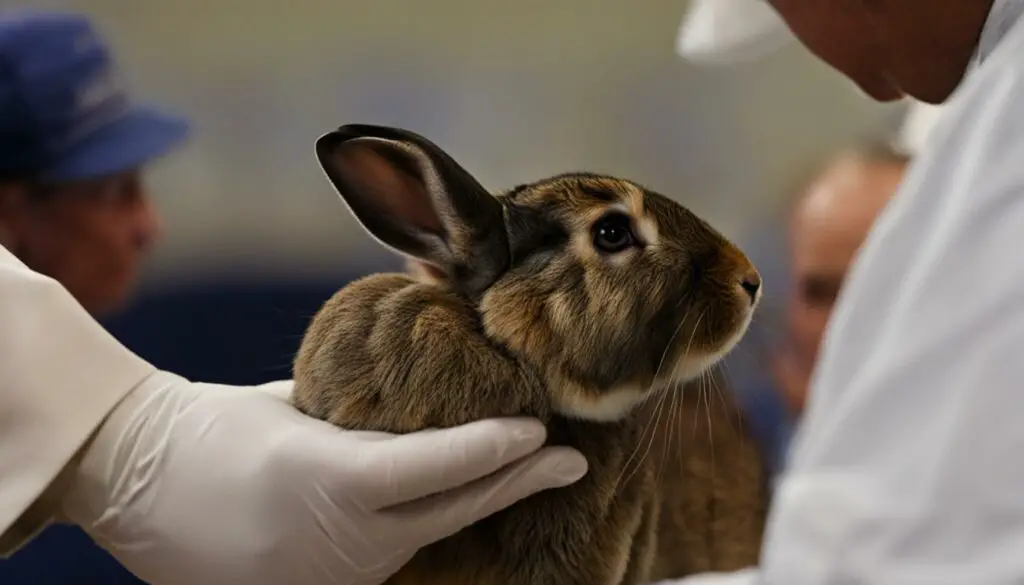
Table: Dewlap Expectations in Select Rabbit Breeds
| Breed | Dewlap Expectations |
|---|---|
| Flemish Giant | Prominent, well-developed, firm, and symmetrical dewlap |
| Netherland Dwarf | Minimal or absent dewlap, smooth transition from neck to chin |
| English Lop | Large and pendulous dewlap, reaching to at least the base of the ears |
| Rex | Minimal or absent dewlap preferred, smooth transition from neck to chin |
Wet Dewlap in Rabbits
One common issue that rabbit owners may encounter is a wet dewlap. Wet dewlap refers to a condition where the fur on a rabbit’s dewlap becomes wet and stays wet for an extended period. This can be caused by various factors, such as drinking from dirty water bowls or leaky water bottles. It can also be a sign of underlying dental problems or obesity.
When a rabbit’s dewlap becomes wet, it can lead to skin inflammation and infection, which can be uncomfortable and potentially harmful to the rabbit’s health. Therefore, it is crucial to address the underlying cause and keep the dewlap clean and dry. Regular grooming is essential for preventing matting and ensuring the overall well-being of the rabbit.
To treat a wet dewlap, start by examining the rabbit’s water source. Ensure that the water bowl or bottle is clean and free from any contaminants. If necessary, consider switching to a different type of water dispenser that will minimize the risk of wetting the dewlap. Additionally, it is advisable to check the rabbit’s teeth and oral health to rule out any underlying dental issues that may contribute to excessive drooling.
In cases where obesity is a contributing factor to the wet dewlap, it is crucial to manage the rabbit’s weight through a balanced diet and regular exercise. Obesity can not only exacerbate the wet dewlap problem but also lead to various other health issues. Consultation with a veterinarian may be necessary to develop a suitable diet and exercise plan for the rabbit to achieve and maintain a healthy weight.
Preventing Wet Dewlap
Prevention is always better than cure when it comes to wet dewlaps in rabbits. Here are some tips to help prevent this condition:
- Provide clean and fresh water to your rabbit in a suitable water dispenser.
- Regularly check and clean the water dispenser to ensure it does not leak or become contaminated.
- Maintain proper dental health for your rabbit through regular check-ups and appropriate dental care.
- Monitor your rabbit’s weight and provide a balanced diet to prevent obesity.
- Engage your rabbit in regular exercise to promote a healthy weight and overall well-being.
By taking these preventive measures, you can help keep your rabbit’s dewlap clean and dry, reducing the risk of wet dewlap and associated health issues.

| Causes of Wet Dewlap | Treatment | Prevention |
|---|---|---|
| Drinking from dirty water bowls or leaky water bottles | Check and clean water dispenser; consider switching to a different type | Provide clean and fresh water; regularly clean water dispenser |
| Underlying dental problems | Consult a veterinarian for dental examination and treatment | Maintain regular dental check-ups and appropriate dental care |
| Obesity | Manage weight through diet and exercise; consult a veterinarian for a suitable plan | Maintain a balanced diet; monitor weight and provide regular exercise |
Lack of Dewlap in Female Rabbits
Not all female rabbits develop dewlaps. The presence or absence of a dewlap can be influenced by factors such as breed and spaying before puberty. Smaller rabbit breeds tend to have smaller or almost non-existent dewlaps. Additionally, spaying a female rabbit before puberty can limit the development of a dewlap, as estrogen production is reduced.
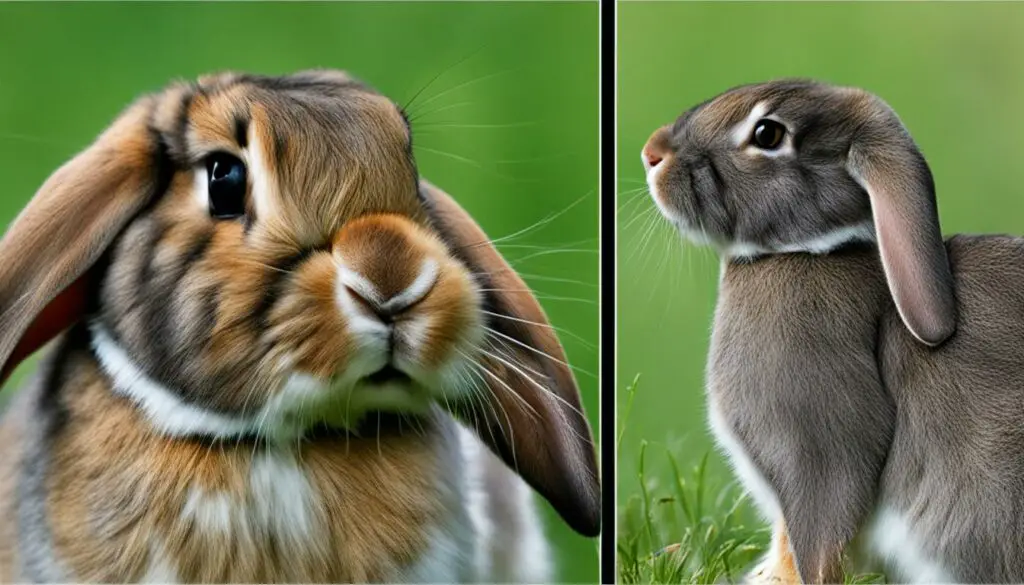
While a lack of dewlap may not be a cause for concern, it’s essential to consider the individual rabbit’s overall health and well-being. Regular veterinary check-ups and monitoring any changes in behavior or appearance can help ensure that the rabbit remains in optimal condition.
It’s important to note that the absence of a dewlap does not indicate any health problems or complications. Each rabbit is unique, and their characteristics can vary based on genetics, breed, and individual development. Providing a loving and supportive environment for the rabbit, regardless of the presence or absence of a dewlap, is key to their happiness and well-being.
Rabbit Dewlap Care: Preventing Common Problems
When it comes to caring for a rabbit’s dewlap, preventive measures are key to ensuring the health and well-being of your furry friend. By understanding the potential issues that can arise and taking proactive steps, you can help prevent common problems associated with rabbit dewlaps. Here are some important tips and practices to keep in mind:
1. Maintain a Healthy Weight
Obesity is a major factor that can contribute to the size of a rabbit’s dewlap. As excess weight is gained, fatty tissue may accumulate in the dewlap area, leading to a larger and more prominent dewlap. To prevent this, it’s essential to provide your rabbit with a balanced diet and regular exercise. Consult with your veterinarian to determine the appropriate portion sizes and types of food for your rabbit’s specific needs. Additionally, ensure that your rabbit has plenty of opportunity for physical activity, such as supervised playtime and regular access to a safe exercise area.
2. Monitor the Dewlap for Irritation or Infection
Rabbit dewlaps are susceptible to skin irritation and infection, particularly when they become moist or dirty. Regularly check your rabbit’s dewlap for any signs of redness, swelling, or discharge. If you notice any abnormalities, gently clean the area with a damp cloth and consult with your veterinarian for further guidance. Additionally, ensure that your rabbit’s living environment is clean and dry to minimize the risk of bacterial or fungal growth.
3. Regular Grooming and Maintenance
Proper grooming is essential for rabbits with larger or more prominent dewlaps. Regularly brush the fur around the dewlap area to prevent matting, which can lead to skin issues. Use a soft brush or comb and be gentle to avoid causing discomfort to your rabbit. If your rabbit’s dewlap is particularly large, you may need to trim the fur around the area to ensure cleanliness. Always use caution when handling scissors near your rabbit and consider seeking professional grooming assistance if needed.
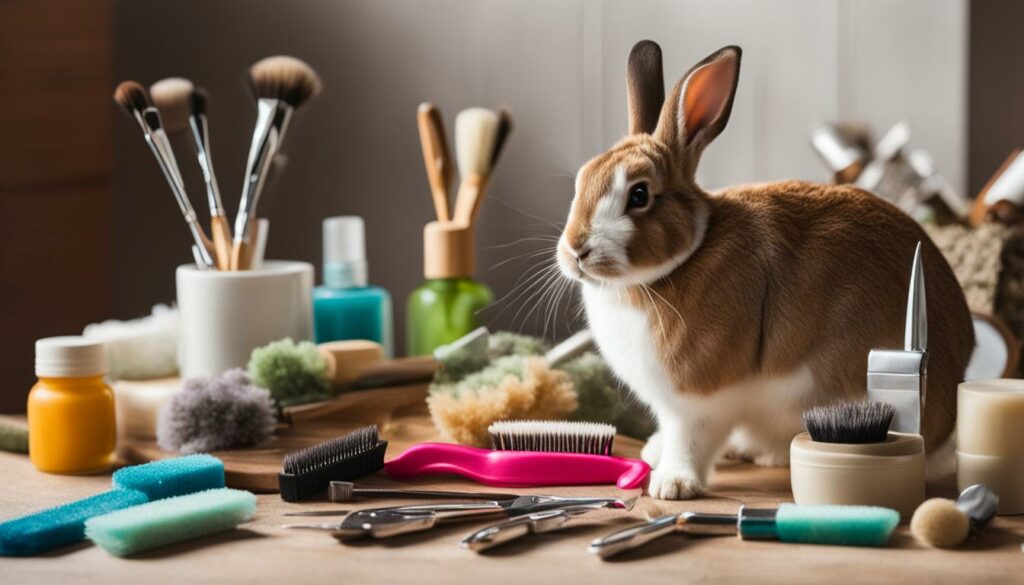
4. Regular Veterinary Check-ups
Regular veterinary check-ups are crucial for the overall health and well-being of your rabbit, including the care of their dewlap. Your veterinarian can assess the size and condition of the dewlap during routine examinations and provide guidance on any necessary preventive measures or treatments. Additionally, they can address any underlying health issues that may contribute to dewlap-related problems.
| Issue | Preventive Measures |
|---|---|
| Obesity | Maintain a balanced diet and provide regular exercise |
| Irritation or infection | Monitor the dewlap for abnormalities and keep the area clean and dry |
| Matted fur | Regularly groom and trim the fur around the dewlap |
By following these preventive measures and providing attentive care, you can help keep your rabbit’s dewlap healthy and minimize the risk of common problems. Remember, each rabbit is unique, and it’s important to tailor their care to their individual needs. If you have any concerns or questions about your rabbit’s dewlap, don’t hesitate to reach out to a qualified veterinarian for guidance and support.
Care and Maintenance of Rabbit Dewlaps
In order to ensure the health and well-being of your rabbit, proper care and maintenance of their dewlap is essential. Regular grooming is necessary to prevent matting and skin issues. For rabbits with larger or more prominent dewlaps, extra care may be needed to keep the area clean and dry. Checking the dewlap regularly for any signs of infection or inflammation is important for maintaining your rabbit’s overall health.
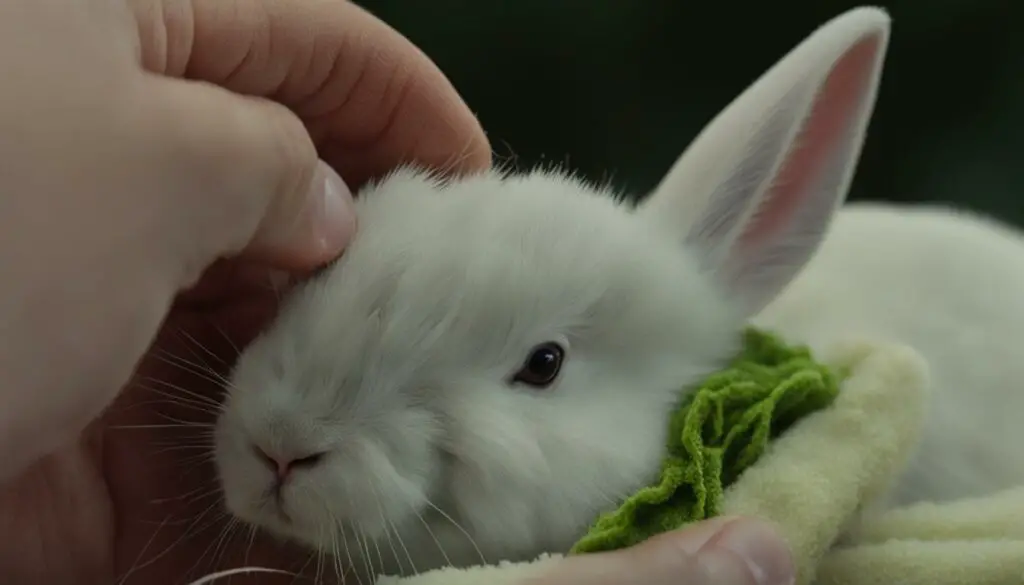
Start by gently examining the dewlap, paying attention to any changes in size, color, or texture. If you notice any redness, swelling, or discharge, it could be a sign of infection or inflammation. In this case, consult with a veterinarian for proper treatment.
Regular grooming of the dewlap involves gently combing through the fur to remove any tangles or mats. Be sure to use a comb with wide teeth, as the skin in the dewlap area can be delicate. If you encounter any stubborn mats, carefully use a pair of blunt-tipped scissors to trim them away. Take care not to cut too close to the skin to avoid injuries.
In addition to grooming, it’s important to keep the dewlap area clean and dry. Avoid using wet wipes or excessive moisture, as this can lead to skin irritation. Instead, use a dry cloth or towel to gently wipe the area, removing any dirt or debris. If your rabbit’s dewlap tends to get moist, consider providing a clean, dry resting area for them to help minimize moisture build-up.
By following these care and maintenance practices, you can help prevent potential issues and ensure the well-being of your rabbit’s dewlap. Remember to monitor the dewlap regularly and seek veterinary care if you notice any concerning changes. With proper care, your rabbit’s dewlap can remain a healthy and natural part of their anatomy.
Surgical Dewlap Reduction
When a rabbit’s dewlap becomes excessively large and causes significant health issues, such as interfering with eating or grooming, surgical dewlap reduction may be recommended by a veterinarian. This procedure involves reducing the size of the dewlap through surgical intervention, providing relief and improving the rabbit’s overall well-being.
Please note that surgical dewlap reduction should always be considered as a last resort due to the risks associated with surgery and anesthesia. It is crucial to explore alternative options and address any underlying health issues before considering this procedure.
If your rabbit’s dewlap is causing major problems and other methods have been exhausted, consult with a qualified veterinarian to discuss the potential benefits, risks, and appropriate timing for surgical dewlap reduction.
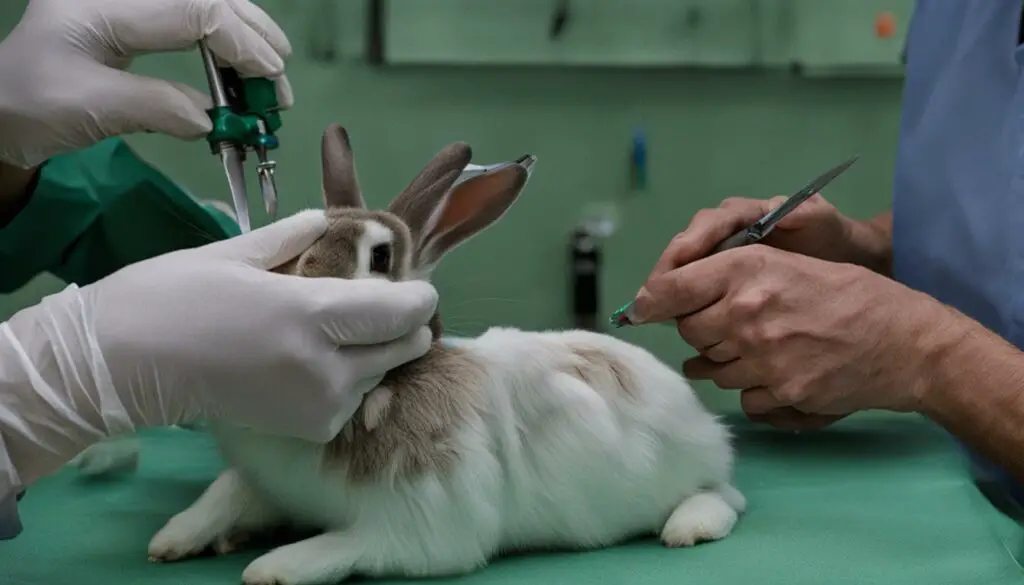
Table: Pros and Cons of Surgical Dewlap Reduction
| Pros | Cons |
|---|---|
|
|
Rabbit Dewlap: A Comprehensive Guide
A dewlap is a pouch of fat beneath the jaw of a female rabbit, especially if they were not spayed early. It is a normal part of rabbit anatomy and can vary in size. Dewlaps are more prominent in large breeds and lop eared rabbits. Female rabbits develop dewlaps to help when it comes time to make a nest for their babies. Male rabbits of these breeds may also develop small dewlaps.
A dewlap appears as a bump or pouch of fur under a rabbit’s chin. Small dewlaps may resemble a double chin, while larger dewlaps can encircle the rabbit’s head. Dewlap size varies depending on the breed and individual genetics. Dewlaps are more prominent in larger breeds like Flemish Giants and lop rabbits.
A female rabbit does not have a dewlap at birth and it starts to develop when she reaches sexual maturity, usually around four to six months old. The dewlap will continue to grow for another year or two until it reaches its full size. Dewlap size is primarily determined by genetics. Excessive pulling of fur from the dewlap or rapid growth may indicate health issues and should be checked by a veterinarian.
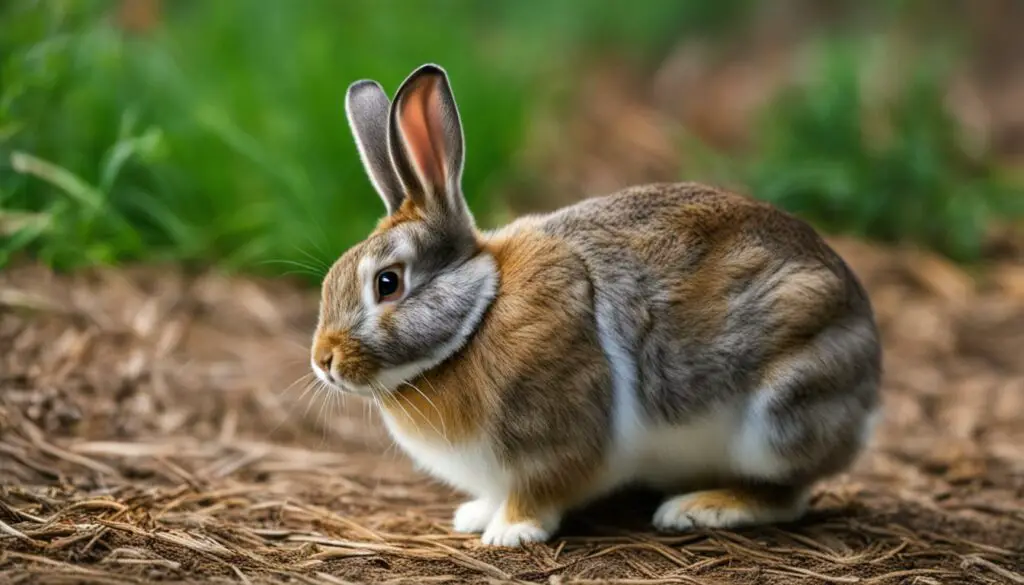
Rabbit dewlaps are a normal and natural part of a female rabbit’s anatomy, although some males may also develop small dewlaps. Dewlap size can vary depending on genetics, breed, and weight. Proper care and maintenance of the dewlap, including regular grooming and monitoring for any signs of health issues, can help ensure the rabbit’s well-being. In extreme cases, surgical dewlap reduction may be necessary, but it should be considered as a last resort.
| Breed | Prominence of Dewlap |
|---|---|
| Flemish Giant | Very prominent |
| Lop Eared | Prominent |
| Mini Rex | Less prominent |
| Dutch | Minimal dewlap |
References
When researching rabbit dewlaps, it is essential to consult reliable sources to ensure accurate information and proper care for your furry friend. Here are some reputable references that can provide valuable insights into rabbit dewlap care:
- Hess, Laurie DVM; Tater, Kathy, DVM. “Dewlap.” Ferrets, Rabbits, and Rodents (Third Edition), ScienceDirect, 2012. [Accessed on August 15, 2022] www.sciencedirect.com/topics/veterinary-science-and-veterinary-medicine/dewlap
- “Spaying and Neutering.” House Rabbit Society. [Accessed on August 15, 2022] rabbit.org/faq-spaying-and-neutering
- Tips and Tricks Newsletter articles.
- Saunders Comprehensive Veterinary Dictionary (Fifth Edition), 2021.
- Clinical Anatomy and Physiology of Exotic Species, 2005.
- Hormones and Reproduction of Vertebrates: Reptiles, 2011.
- Ferrets, Rabbits, and Rodents (Third Edition), 2012.
These references cover a wide range of topics related to rabbit dewlaps, including their characteristics, development, health concerns, and care. By consulting these sources, you can enhance your understanding of rabbit dewlaps and provide the best possible care for your beloved furry companion.
FAQ
What is a dewlap in rabbits?
A dewlap is a pouch of fat beneath the jaw of a female rabbit, especially if they were not spayed early. It is a normal part of rabbit anatomy and can vary in size.
When does a rabbit’s dewlap develop?
A female rabbit does not have a dewlap at birth and it starts to develop when she reaches sexual maturity, usually around four to six months old. The dewlap will continue to grow for another year or two until it reaches its full size.
Are dewlaps only found in female rabbits?
No, male rabbits of certain breeds may also develop small dewlaps, although it is less common compared to female rabbits.
Can a rabbit’s dewlap cause health issues?
While a dewlap is a normal and healthy feature, a very large dewlap can make grooming, eating, and drinking difficult for the rabbit and can lead to skin irritation or infections. Obesity can also contribute to the size of a rabbit’s dewlap.
What should I do if my rabbit’s dewlap is wet?
A wet dewlap can be caused by various factors, such as drinking from dirty water bowls or underlying health issues. It is important to address the underlying cause and keep the dewlap clean and dry to prevent skin inflammation and infection.
Can all female rabbits develop a dewlap?
Not all female rabbits develop dewlaps. Factors such as breed and spaying before puberty can influence the presence or absence of a dewlap.
How does obesity affect a rabbit’s dewlap?
Obesity can contribute to the size of a rabbit’s dewlap. As a rabbit gains weight, the dewlap may increase in size due to the accumulation of fatty tissue.
How do I care for and maintain my rabbit’s dewlap?
Proper care and maintenance involve regular grooming to prevent matting and skin issues. For rabbits with larger or more prominent dewlaps, extra care may be needed to keep the area clean and dry. Regularly checking for any signs of infection or inflammation is important for maintaining the rabbit’s overall health and well-being.
What is surgical dewlap reduction?
In extreme cases where a rabbit’s dewlap is causing significant health issues, a veterinarian may recommend surgical dewlap reduction. This procedure involves reducing the size of the dewlap through surgical intervention.
Do you have any other resources or references?
Yes, here are some resources and references you may find helpful:
– “Dewlap.” Ferrets, Rabbits, and Rodents (Third Edition), ScienceDirect, 2012.
– “Spaying and Neutering.” House Rabbit Society.
– Tips and Tricks Newsletter articles.
– Saunders Comprehensive Veterinary Dictionary (Fifth Edition), 2021.
– Clinical Anatomy and Physiology of Exotic Species, 2005.
– Hormones and Reproduction of Vertebrates: Reptiles, 2011.
– Ferrets, Rabbits, and Rodents (Third Edition), 2012.

